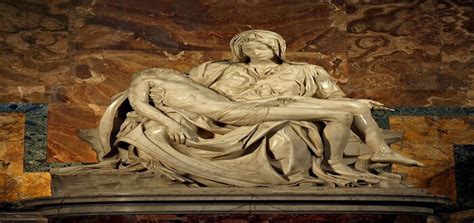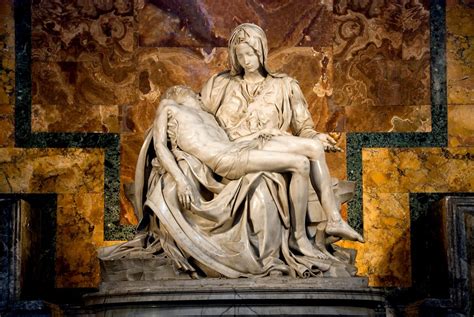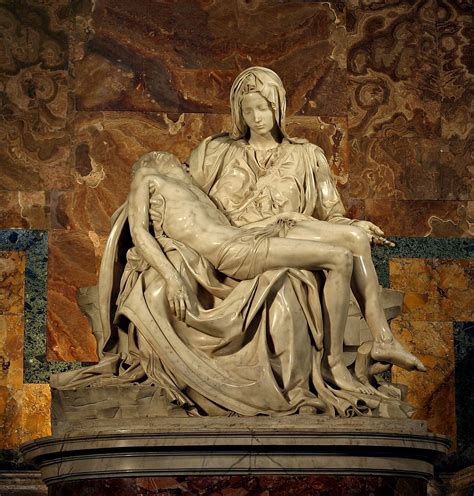Michelangelo’s La Pietà stands as an enduring symbol of artistic brilliance and emotional depth, captivating audiences for centuries. This iconic sculpture, housed in St. Peter’s Basilica in Vatican City, masterfully depicts the Virgin Mary cradling the lifeless body of Jesus Christ. Crafted by Michelangelo at the young age of 24, La Pietà showcases his unparalleled skill in rendering the delicate interplay of human emotion and divine grace. This article delves into the intricate details of La Pietà, exploring why it is revered as a masterpiece, the inspiration behind its creation, the meticulous process of its sculpting, its preservation, symbolism, unique characteristics, lasting impact, and how it continues to inspire viewers around the world today.
Join gamesfats.com as we delve deeply into this topic.
1. Why La Pietà is a Masterpiece
La Pietà is hailed as a masterpiece for numerous reasons. Michelangelo’s extraordinary craftsmanship is evident in the sculpture’s intricate details and lifelike portrayal of both figures. The delicate folds of Mary’s robes, the realistic anatomy of Jesus, and the tender expression on Mary’s face all contribute to its breathtaking realism. Michelangelo achieved an incredible balance between human emotion and divine serenity, capturing the profound sorrow of a mother while maintaining a sense of heavenly peace. The composition’s triangular structure, with Mary’s head at the apex and Jesus’ body draped across her lap, creates a harmonious and stable form. Additionally, Michelangelo’s innovative use of a single block of Carrara marble demonstrates his technical prowess and vision, transforming raw stone into an exquisite work of art. La Pietà’s timeless beauty and emotional depth have cemented its place as one of the greatest achievements in art history, continuously inspiring admiration and reverence.

2. Why Michelangelo Created La PietÃ
Michelangelo created La Pietà in response to a commission from the French Cardinal Jean de Bilhères, who wanted a remarkable sculpture for his tomb in St. Peter’s Basilica. The commission was an opportunity for Michelangelo to showcase his talent and gain recognition in the highly competitive art world of Renaissance Italy. Michelangelo sought to convey both the human and divine aspects of the biblical scene, focusing on the profound sorrow and maternal compassion of the Virgin Mary as she holds her deceased son.
At the time, Michelangelo was only 24 years old, yet he was determined to make a bold statement with his work. He aimed to push the boundaries of sculptural art, demonstrating his ability to infuse stone with lifelike emotion and grace. His interpretation of the Pietà deviated from the traditional depictions by portraying Mary as youthful and serene, emphasizing her purity and eternal beauty. This innovative approach not only highlighted his artistic vision but also resonated deeply with viewers, elevating his status as one of the greatest sculptors of his time.

3. How La Pietà Was Sculpted
Michelangelo sculpted La Pietà from a single block of pristine Carrara marble, a material renowned for its quality and favored by Renaissance artists. The process began with meticulous planning and detailed sketches, through which Michelangelo envisioned the final composition. He then created a small-scale model to refine his ideas and ensure the proportions and balance were perfect before transferring them to the marble.
The actual sculpting involved labor-intensive techniques, where Michelangelo first used a point chisel to rough out the basic shapes. He then employed finer tools such as tooth chisels, rasps, and abrasive stones to carve the intricate details. His mastery of these tools allowed him to achieve the delicate textures and subtle nuances of the human form, evident in the flowing drapery of Mary’s robes and the lifelike anatomy of Jesus’ body.
Michelangelo’s unparalleled skill in handling the marble is showcased in the seamless integration of the figures, creating an illusion of softness and fluidity despite the hardness of the stone. The painstaking process, combining technical precision with artistic vision, resulted in a sculpture that exudes both realism and divine beauty, solidifying Michelangelo’s reputation as a master sculptor.

4. How La Pietà Has Been Preserved
La Pietà has undergone several preservation efforts to maintain its pristine condition and ensure its longevity. Initially, the sculpture’s location within St. Peter’s Basilica provided a relatively stable environment, protecting it from the elements and major damage for centuries. However, the passage of time and human interaction necessitated more proactive conservation measures.
In 1972, a significant preservation challenge arose when the sculpture was attacked by a disturbed individual wielding a hammer, causing considerable damage to Mary’s face and arm. This event prompted an extensive restoration project. Experts meticulously collected and reassembled the fragmented pieces, using advanced techniques to restore the sculpture as closely as possible to its original state. The restoration process involved using marble dust and resin to seamlessly blend the repairs with the existing marble, ensuring the integrity and appearance of the masterpiece.
To prevent future damage, La Pietà was subsequently placed behind bulletproof glass, providing both physical protection and climate control. This measure safeguards the sculpture from environmental fluctuations and potential vandalism, while still allowing visitors to appreciate its beauty up close. Additionally, regular monitoring and maintenance are conducted by art conservation specialists to address any signs of wear or deterioration, ensuring that La Pietà continues to inspire and captivate audiences for generat

5. What La Pietà Represents
La Pietà represents a profound convergence of human emotion and divine grace. At its core, the sculpture captures the poignant moment of the Virgin Mary cradling the lifeless body of Jesus Christ, evoking a deep sense of sorrow and maternal compassion. This representation of Mary as a youthful and serene figure, despite her immense grief, emphasizes her purity and eternal beauty, reinforcing her role as a symbol of divine love and sacrifice.
Moreover, La Pietà embodies the Christian themes of redemption and salvation. The lifeless body of Jesus signifies his sacrifice for humanity’s sins, while Mary’s calm demeanor suggests a sense of acceptance and faith in the divine plan. Michelangelo’s masterful execution of these themes through the sculpture’s composition, emotion, and intricate details creates a powerful narrative that resonates deeply with viewers.
The sculpture’s timeless beauty and emotional depth transcend religious boundaries, making it a universal symbol of love, loss, and hope, inspiring countless individuals regardless of their faith or background.

6. What Makes La Pietà Unique
La Pietà’s uniqueness lies in Michelangelo’s revolutionary approach to both its artistic and emotional elements. Unlike traditional depictions of the Pietà, Michelangelo chose to portray Mary as youthful and serene rather than older and overtly sorrowful. This depiction underscores her purity and eternal beauty, setting it apart from other representations.
The sculpture’s composition is another distinctive feature. Michelangelo’s use of the pyramidal structure, with Mary’s head forming the apex and Jesus’ body creating the base, provides a harmonious and stable form. This balance enhances the sculpture’s visual impact, drawing viewers into the emotional and spiritual narrative.
Moreover, the incredible detail and lifelike quality of the figures are testament to Michelangelo’s unparalleled skill. The delicate folds of Mary’s robes, the realistic anatomy of Jesus, and the tender expressions contribute to its breathtaking realism. Michelangelo’s ability to transform a single block of Carrara marble into such a profound and intricate masterpiece further distinguishes La Pietà.
The sculpture’s ability to convey complex human emotions and divine grace simultaneously, combined with its innovative artistic techniques, cements its status as a unique and timeless masterpiece in the history of

7. Why La Pietà Continues to Inspire
La Pietà continues to inspire due to its profound emotional depth and technical brilliance. Michelangelo’s masterful depiction of the Virgin Mary and Jesus Christ captures a poignant moment of sorrow and divine grace, resonating deeply with viewers across different cultures and eras. The sculpture’s ability to convey intense human emotion through marble—a medium often perceived as cold and unyielding—demonstrates the artist’s extraordinary skill and vision.
The timeless beauty of La Pietà also plays a significant role in its enduring impact. Its harmonious composition and lifelike detail create a powerful visual experience that transcends the bounds of religious context, appealing to a universal sense of empathy and beauty. Additionally, La Pietà’s historical significance and the story behind its creation add layers of meaning, making it a source of inspiration not only for art enthusiasts but also for those who find solace and motivation in

8. How to View La Pietà Today
Today, La Pietà is prominently displayed in St. Peter’s Basilica in Vatican City, where it remains one of the most visited and admired artworks in the world. The sculpture is housed within a protective glass case to safeguard it from environmental damage and potential vandalism. This glass enclosure allows for close viewing while maintaining the sculpture’s preservation.
Visitors can view La Pietà by entering St. Peter’s Basilica through the main entrance and proceeding to the central nave, where the sculpture is prominently positioned. The protective glass case ensures that viewers can appreciate the intricate details and emotional depth of the piece without compromising its safety.
For those unable to visit in person, high-quality images and virtual tours of La Pietà are available online, providing a detailed view of the sculpture’s features. Museums and art institutions often include La Pietà in educational resources and exhibitions, further extending its reach and impact. Engaging with these resources allows individuals around the world to experience and appreciate Michelangelo’s masterpiece from afar.

La Pietà remains a timeless testament to Michelangelo’s genius and artistic vision, embodying profound emotion and divine beauty. Its unique portrayal of Mary and Jesus, combined with unparalleled craftsmanship, continues to captivate and inspire viewers across the globe. Whether experienced in person or through virtual means, La Pietà’s enduring legacy highlights its significance in art history and its power to evoke deep reflection and admiration.
gamesfats.com

